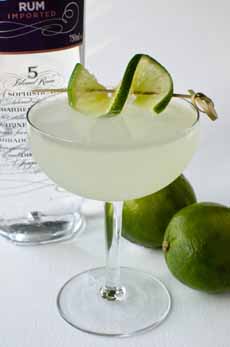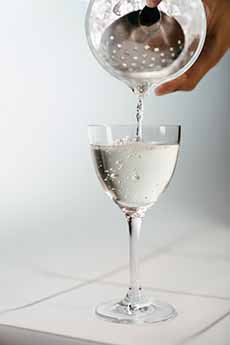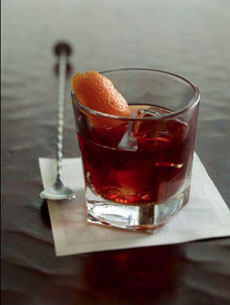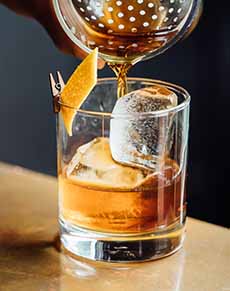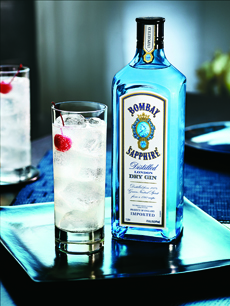TIP OF THE DAY: Have A Retro Cocktail Party
|
Cranberry Mojitos, Dirty Martinis, Frozen Mango Margaritas…none of these cocktails existed when your parents (for Baby Boomers and Gen X) or grandparents (for everyone else) had their first cocktails. None would be featured on “Mad Men.”
How many people do you know who have even had a Daiquiri, Old Fashioned, or Tom Collins? A retro cocktail party may be just the thing to introduce them to tippling in the good old days. So banish the Cosmopolitans for an evening, and turn back the clock with a menu of five classic cocktails. These famous oldies date to the 1800s. > Also below, retro hors d’oeuvre to serve with the cocktails. > Plus, the history of cocktails. 1. Daiquiri: Ernest Hemingway’s favorite cocktail combines rum, lime juice, and simple syrup, shaken and served neat (photo #1). Here’s the history of the Daiquiri. 2. Dry Martini: This combination of gin and dry vermouth is garnished with an olive or lemon twist garnish. The less vermouth, the drier the Martini. People who wanted to drink straight gin could ask for just a splash of it. It’s the only cocktail in this group that isn’t sweet. From early times, people used sugar to mitigate the hard edge of the alcohol (photo #2). Here’s the history of the Martini. 3. Manhattan: This classic whiskey cocktail, dating to the 1870s, is made with bourbon or rye and sweet vermouth, served in a rocks glass and originally garnished with a maraschino cherry, although today orange peel is often substituted (photo #1). A gin-based version is the Martinez, another oldie made with sweet vermouth, bitters and the cherry. That recipe was first published in 1887, attributed to a bar in Martinez, California (photo #3). Here’s the history of the Manhattan cocktail. 4. Old Fashioned: Bourbon based and served in a rocks glass, sugar, bitters, and an orange slice are muddled in the glass; ice and bourbon are then added. The term originated with late 19th-century bar patrons, to distinguish cocktails made the “old-fashioned” way from newer, more complex cocktails (photo #4). Here’s the history of the Old Fashioned cocktail. 5. Tom Collins: A tall drink of dry gin, lemon juice, sugar syrup, and soda water, garnished with a maraschino cherry and a lemon slice (photo #5). The recipe was first published in 1876. There was no particular Tom Collins for whom it was named; rather, “Tom Collins” was an everyman name referenced in conversation, along the lines of John Smith and John Doe. Here’s the history of the Tom Collins. Bonus option: 6. Mint Julep: Not just for Kentucky Derby parties, this tall glass of muddled mint and sugar syrup, crushed ice and bourbon deserves attention year-round (photo #6). It originated in the South in the 1800s. A julep is generally defined “as a sweet drink, particularly one used as a vehicle for medicine.”* Here’s the history of the Mint Julep. Here’s the history of the Mint Julep. *Source: Wikipedia. It should be noted that before it became a leisure drink, spirits were developed for, and used as, medicine. |
|
|
|
|
||
|
|
RETRO HORS D’OEUVRE
The mixture of ingredients that became known as a cocktail predates the use of the word. In the 18th century, drinks combining a spirit, sweetener, water, and bitters were mixed, and bitters were often sipped for medicinal purposes. Plus, the concept of punch as a sweetened mixed drink made in a quantity to serve several people originated in India. European sailors and traders encountered it there in the 17th century. The British East India Company is credited with bringing punch recipes back to England. Although in India punch was not alcoholic, it became so in Europe. Spirits (usually rum) were added to the Indian recipe of tea, water, sugar, citrus, and spices. Thus, the individually mixed drink called the cocktail was a simple evolution. Individual cocktails as we know them today have existed since the early 1800s. The first known mention of the word “cocktail” was used to describe a mixed drink in 1803, appearing in a newspaper called The Farmer’s Cabinet in Amherst, New Hampshire [source]. A few years later, a reader wrote to The Balance and Columbian Repository, a newspaper in Hudson, New York, asking “What is a cocktail?” The reply, published in the May 13, 1806: “Cock-tail is a stimulating liquor, composed of spirits of any kind, sugar, water, and bitters—it is vulgarly called bittered sling….” The term gradually came to reference any kind of alcoholic mixed drink, specifying, for example “gin cocktail.” It took several decades for the first published bartenders’ guide with cocktail recipes. How to Mix Drinks; or, The Bon Vivant’s Companion, by “Professor” Jerry Thomas, appeared in 1862 and is still in print! In addition to recipes for “cocktails,” there cobblers, flips, punches, shrubs, slings, and toddies. Bitters was the key ingredient that differentiated cocktail recipes. |
|
|
Bitters are combinations of herbs, fruits, spices and/or roots, distilled in a base liquor. As with spirits, they began as medicinal tonics. Classic cocktails with bitters include the Manhattan, Negroni, Old Fashioned, Pisco Sour, Rob Roy, Rum Swizzle, Sazerac and Singapore Sling. The recent renaissance in artisan bitters has led to more of their use in new creations. The leading claim to the first cocktail party goes to Mrs. Julius S. Walsh Jr. of St. Louis, Missouri. In May 1917, she invited 50 guests to her home at noon on a Sunday. The cocktail reception lasted an hour, and lunch was served at 1 p.m. While the record is mum on the subject, the cocktail event may have followed the Sunday church service.† Now there’s an idea ready for revival: church followed by cocktails with friends. The origin of the word “cocktail” remains a mystery. It appears to have originated at the beginning of the 1800s. Here are the leading theories: _____________ †Since 1924, the Walsh mansion has been the residence of the archbishop of the Roman Catholic Archdiocese of St. Louis. CHECK OUT WHAT’S HAPPENING ON OUR HOME PAGE, THENIBBLE.COM. |
||
